Posted by Elena del Valle on May 10, 2018

Meet the Frugalwoods
Photos: Courtesy of HarperBusiness, Nate Thames
The rat race sometimes gets to be a bit much, dragging down the best of us. A few lucky people discover a way out. Fewer still find financial independence of some kind and share the story of how they did it. Elizabeth Willard Thames and her husband Nate are working yet living life on their own terms. While many may not want to relocate permanently to remote and rural Vermont as they did achieving their goal of financial independence may appeal to many of us.
In Meet the Frugalwoods Achieving Financial Independence Through Simple Living (Harper Business, $22.99), a 229-page hardcover book published recently, Elizabeth Thames shares the experiences in life and work that led her and her husband to quit their jobs and leave a conventional life in upscale Cambridge, Massachusetts in search of a more meaningful and satisfying life in the country. She also explains in general terms how they followed a more frugal than most approach for years that allowed them to save enough (as much as 70 percent of their take home income at times) to make big purchases with relative ease without having to always borrow for a mortgage or bank loan.
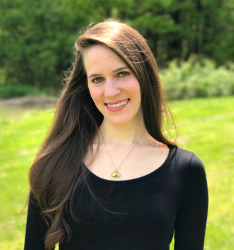
Elizabeth Willard Thames, author, Meet the Frugalwoods
Thames is the blog voice behind the Frugalwoods website, focusing on personal finance from her personal perspective. She, her husband and their small children live in a homestead in the Vermont woods. She did not respond to questions submitted more than one week in advance via her publishing company.
Thames holds undergraduate degrees in political science and creative writing from the University of Kansas and an masters in public administration from American University. Prior to following her calling as a writer and homesteader, she worked for ten years in the nonprofit sector as a fund-raiser and communications manager.

Click to buy Meet the Frugalwoods
Comments:
Filed Under: Books
Posted by Elena del Valle on May 3, 2018

The Making of a Massacre
Images: Audible, ProPulica
On May 4, 2018 the final parts of The Making of a Massacre, a five-part audio series (The first part of the series is already available for Audible members on the company website) should become available. In the series, Ginger Thompson, investigative reporter, ProPublica, takes listeners through the nonfiction story of the disappearance of dozens of people from Allende, a small Mexican border town. She relies on interviews, English voice over excerpts of interviews with townspeople, officials, and cartel members to illustrate “the way in which well-intentioned efforts to curtail the drug trade had devastating real-life results.”
The review edition of the audio recording, about two hours long, had uneven volume and at times it was difficult to distinguish sounds and words from sound effects and background noises. Despite multiple requests submitted two weeks in advance via a publishing company representative first and later directly to the journalist, Thompson declined to respond to questions about the recording.

Ginger Thompson
According to promotional materials, Thompson spent 15 years at The New York Times, including time as a Washington correspondent and as an investigative reporter whose stories revealed Washington’s secret role in Mexico’s fight against drug traffickers. While at The Times, she covered Mexico’s transformation from a one-party state to a fledgling multi-party democracy and into breaking news events across the region, including Cuba, Haiti and Venezuela.
For her work in the region, she was a finalist for The Pulitzer’s Gold Medal for Public Service. She won the Maria Moors Cabot Prize, the Selden Ring Award for investigative reporting, an InterAmerican Press Association Award, and an Overseas Press Club Award. Thompson was also part of a team of national reporters at The Times that was awarded a 2000 Pulitzer Prize for the series How Race is Lived in America.
Comments:
Filed Under: Books
Posted by Elena del Valle on April 12, 2018
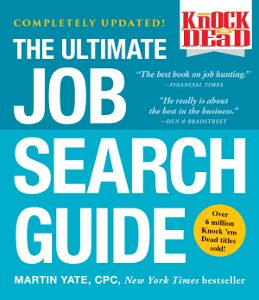
The Ultimate Job Search Guide
Photos: Simon and Schuster, Knock ’em Dead
For 32 years Martin Yate, CPC has been “thinking about, writing and helping people through the issues that can advance a career or get a stalled one back on track.” During that time he has shared his insights in 18 books in 85 editions. Updating existing books requires approximately three months of work. In the 32nd edition of Knock ’em Dead: The Ultimate Job Search Guide (Adams Media, $17.99) published last year he outlines his latest tips for job finding.
When asked about the target audience for his book he replied by email “…anyone who can read, wants to be successful, achieve financial stability and live a personally fulfilled life. The professional world. I have readers who started with me after graduation and now make speeches at Davos & G7, single parents struggling to get ahead from a bad starting place, and everything in between. I have honed a comprehensive and completely new approach to career management that makes sense to anyone at any age, professional title, socio-economic status or situation. I don’t waste words so every page of every book offers common-sense advice that anyone can apply to their unique situations, which is all focused on you personally, achieving success, stability and fulfillment.”
The 400-page softcover book is divided into 30 chapters and four parts: The Well-Stocked Briefcase, Get the Word Out, Great Answers to Tough Interview Questions and Finishing Touches. It addresses age discrimination, career changes, confidential job searches, staying ahead of disruptions as well as answering tricky and touch interview questions, social media and other job search and job finding issues. The chapters include tips, highlighted in a blue background.
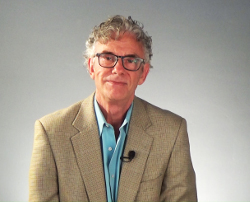
Martin Yate, CP, author, The Ultimate Job Search Guide
“My 360 degree understanding of career issues that come from being one of the early Silicon Valley international technology headhunters, Director of HR at Bell Computer Memory Division, Dir of Training & Development at world’s 3rd largest employment services company, and spending the majority of my waking moments for 32 years, thinking about, writing and helping people through the issues that can advance a career or get a stalled one back on track,” the author said when asked about his qualifications to write the book.
When asked about the impact of artificial intelligence on the job market he replied, “It’s too scary to think about but think and prepare we must because since 1948, recessions have come round with regularity every 7-10 years; each time they get a little deeper, with longer recovery every time. The last one topped out at 10 percent unemployment in 2012, and 6 percent of our workforce are discouraged workers many of whom lost their ability to make a living because of the impact of earlier waves of technology adoption.
Now let’s add in the impact of AI: No less an authority than Forrester Research released a report last year on the impact of of AI on employment by 2027, the highlights are: We will lose 16 percent of all jobs, at all levels, in all industries and professions and that 30 percent of today’s heritage technology companies will cease to exist. Put these facts together and we could be looking at 20 percent+ unemployment.”
To the question of what jobs might be available in the next decade he replied, “The same Forrester report predicted 9 percent of new jobs created will be in AI. Beyond this it is almost impossible to say. I have a belief that this upheaval will necessarily increase entrepreneurial endeavor. Beyond that the safest jobs will be those that are driven by demographics (example the aging population), or require interaction with the customer, making the professional trades more appealing.”
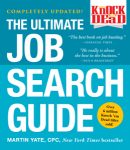 Click to buy Knock ’em Dead: The Ultimate Job Search Guide
Click to buy Knock ’em Dead: The Ultimate Job Search Guide
Comments:
Filed Under: Books
Posted by Elena del Valle on March 28, 2018
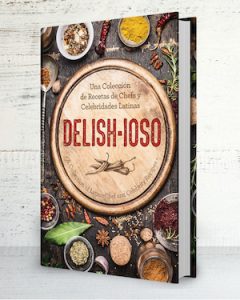
Delish-ioso
Photos: Eclipse Marketing Services, Inc., delishioscookbook.com
In 2017, nine women and eight men television stars, entertainers and celebrity chefs, most Spanish language celebrities with ties to Latin America, shared 45 recipes of favorite dishes in Nexos Latinos’ Delish-ioso: A Collection of Latino Chef and Celebrity Recipes (Eclipse Marketing Services, Inc., $35). The publication targets bilingual and bicultural Hispanic American food lovers, who are family oriented, like “to spend time cooking and following Latino celebrities; also favor brands and products that give back to the community.”
The full color book includes recipes in Spanish and English, in that order, and the Spanish language font is larger than the English language font. It features recipes from Colombia, Cuba, Dominican Republic, Mexico, Puerto Rico, and Venezuela.

Farruko, contributor, Delish-ioso
The 234-page hardcover book printed in the United States includes page sized photos of the contributors and dishes as well as cultural tidbits about the recipes. The project required one year from idea to publication and features the work of 53 photographers. The publisher partnered with Hudson County Community College (HCCC). According to promotional materials, for every book sold a portion of the net profit will be donated to the HCCC Foundation to benefit its culinary arts program.
To the question of what portion of the net profits exactly will be donated to HCCC, a spokesperson replied by email as follows: “With the sale of every book we will be donating a portion of the net profits to the Culinary Arts Institute of the Hudson County Community College (HCCC). The HCCC Culinary Arts and Hospitality Management program is nationally recognized for excellence and was ranked sixth ‘Best Culinary School’ in the U.S. by ‘Best Choice Schools.’ The HCCC is also designated as a Hispanic-Serving Institution (HSI), one of only 275 colleges and universities in the U.S. recognized as such by the Hispanic Association of Colleges and Universities (HACU). By partnering on this cookbook, the college will benefit from a portion of the net profits, and have the ability to continue awarding distinguished students financial scholarships.”
The cookbook’s editor-in-chief was Donna Hernández, who, according to promotional materials has over 20 years of experience with the United States Hispanic market. Hernández invited celebrities she had worked with in the past to be a part of the project.

Lorena Garcia, contributor, Delish-ioso
The project participants, who will receive no financial remuneration for their recipes, are: Karla Martinez, TV host, Univision; Ingrid Hoffmann, celebrity chef; Luis Coronel, singer; Jacob Forever (Yosdani Jacob Carmenates), singer; Sharlene Taule, actress and singer; Helen Ochoa, singer; James Tahhan, celebrity chef, Telemundo; Jonatan Sanchez, singer; Lorena Garcia, celebrity chef; Jessica Carrillo, TV host, Telemundo; Farruko (Carlos Efrén Reyes Rosado), singer; Silvestre Dangond, singer; Vianney Rodriguez, blogger, sweetlifebake.com; Leslie Grace (Leslie Grace Martinez), singer; Adriel Favela, singer; and Omar Giner, chef and restaurant owner.
Nexos Latinos is a magazine and brand published by Eclipse Marketing Services, Inc. Nexos Latinos and Eclipse Marketing Services are owned by Margaret Boller, who is the chief executive officer and Founder. The cookbook is available exclusively on the company website.
Comments:
Filed Under: Books
Posted by Elena del Valle on March 8, 2018
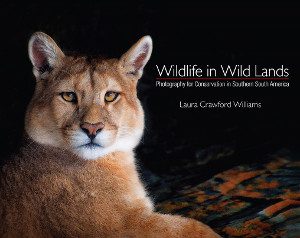
Wildlife in Wild Lands
Photos: Laura Crawford Williams
After years of intense work at a software company in the 1990s Laura Crawford Williams needed to recharge so she turned her attention to wildlife photography. She began near her home and in time traveled far away to capture images that were published in wildlife magazines. She has spent 18 years as a wildlife conservation photographer. In October 2017, Wildlife in Wild Lands Photography for Conservation in Southern South America (My Wild Life Press, $34.95), her first photography book, was published.
“I never intended to become a professional wildlife photographer. I was simply doing what I love to do,” she said by email through her publicist when asked about her work.
She used two Nikon D4s camera bodies with various professional lenses, filters, and a tripod. All photography was completed between 2007 and 2015 for the 230-page softcover book. Book conception and production, at its earliest stages, began in November of 2015.
When asked about her goal in publishing the book she replied, “We are the only species with the ability to modify the planet so significantly that we affect the lives of every other species living here. As a result, species are disappearing at an unprecedented rate. We must all participate in the protection of habitats and species as citizens, organizations, federal entities, and local governments. This project is my labor of love to that end. I hope to inspire in others, my own desperate desire to protect the natural world – every tiny, amazing piece of it!”
The book has six chapters, in English and Spanish, and 150 large (some occupying most of the page) photographs of 113 species; each with captions describing behavior, conservation challenges and status. There are 66 photos in a final chapter, titled Between Frames, with accompanying descriptions of her work and adventures in the field.
She photographed several animals in rehabilitation centers where animals are unable to be re-released due to injury or illness. Images of captive animals are labeled in the accompanying caption.
When asked about enhancement software and modification of the photos from their raw originals she replied, “Nikon RAW files were brought into Photo Mechanic and selected files were converted to TIFF format. TIFF files were then opened in Photoshop for global edits such as contrast, saturation, color-balance, noise, sharpening, cropping, or straightening, as needed or desired. I call these global edits since they are applied to the entire image and not to selected areas. Occasionally, when I felt the image would benefit visually by focusing on the subject more directly, I’d add a vignette or graduated neutral density filter via Photoshop (if I had not already done so in the field). I will also sharpen selectively as needed.”

Laura Crawford Williams
“I did not receive any money or in kind contributions from a third party in exchange for promotion, mention in the book,” the photographer replied when asked whether she received money or in kind contributions from a third party in exchange for promotion, mention in the book. “Sponsorship and endorsement were given and offered freely. We raised $60,126 during a 30 day Kickstarter campaign in October. However, once we paid the required Kickstarter fees, costs related to reward production/fulfillment, and income tax we were left with just over half that amount. I financed the entire project outside of the Kickstarter contribution. All money earned via sales and presentation goes toward reimbursement for the remaining book production and marketing costs. Once the production and marketing budget is reimbursed, any and all proceeds will go into an account setup specifically for the printing of additional editions. This is the agreement I made with the National Parks Association, National Parks Foundation, and President Mauricio Macri of Argentina.”
Crawford Williams plans to publish two more photography books. “People have been asking if I would write a book about my adventures in the field with my team,” she said when asked about future books. “Audiences have thoroughly enjoyed hearing stories about being on the road in some of the most remote areas of the world, as well as about working with potentially dangerous species. They can’t believe some of the uncomfortable challenges we had to overcome. As for the second one, I have a large collection of images taken while living and working in the prairies of Iowa, Nebraska, and South Dakota for 12 years. I’d like to showcase the best of this collection and inspire people to appreciate the subtle and fragile beauty found in our prairie ecosystems.”
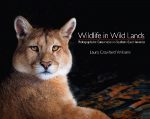
Click to buy Wildlife in Wild Lands (English and Spanish Edition)
Comments:
Filed Under: Books
Posted by Elena del Valle on February 15, 2018
Jill Filipovic, a contributing opinion writer for The New York Times, believes women want the freedom to pursue happiness without gender, class, location and identity biases and constraints. In The H-Spot The Feminist Pursuit of Happiness (Hachette Audio, $30) she discusses her experiences, her research and the impressions she formed from conversations with some women and men from various parts of the country.
In the audiobook, narrated by the author, she explores the history of working women in the United States and her concerns about the pervasive inequality that plagues our country. She outlines the burden presented by high standards of feminine perfection for women and the requirement that they be willing to sacrifice their happiness and well being for their loved ones, while she acknowledges that some of the standards are perpetuated by women. She highlights that the requirements for being a “good mother” have never been so extreme. The author points out the need for political and social changes at the national level.
Multiple requests over several weeks to respond to book related questions and for a book image via her website, Twitter and her publisher were unanswered. According to a biography for Filipovic on her publisher’s website she is a regular columnist for Cosmopolitan.com, where she was previously a senior political writer. A former columnist for the Guardian, she is also an attorney. The biography also indicates that her work on law, politics, gender and foreign affairs has appeared in The Washington Post, Time, Nation, and Foreign Policy.
Click to buy The H-Spot
Comments:
Filed Under: Books
Posted by Elena del Valle on January 15, 2018
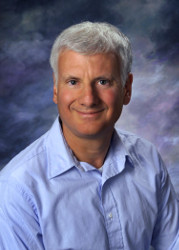
Joseph Pizzorno, N.D., author, The Toxin Solution
Photo: Joseph Pizzorno
A podcast interview with author Joseph Pizzorno, N.D. is available in the Podcast Section of Hispanic Marketing & Public Relations, HispanicMPR.com. During the podcast, he discusses The Toxin Solution (see Naturopath discusses hidden toxins in our lives and how to be rid of them) with Elena del Valle, host of the HispanicMPR.com podcast.
He has been an academic, intellectual and clinical leader in functional integrative and natural medicine for four decades. Pizzorno is also editor-in-chief, Integrative Medicine, and A Clinician’s Journal; as well as president, SaluGenecists, Inc., and treasurer, board of directors, Institute for Functional Medicine, and founding president, Bastyr University.
To listen to the interview, scroll down until you see “Podcast Joseph Pizzorno, ND” on the right hand side, then select “HMPR ” and click on the play button below or download the MP3 file to your iPod or MP3 player to listen on the go, in your car or at home from the RSS feed. Some software will not allow flash, which may be necessary for the play button and podcast player. If that is your case, you will need to download the file to play it. To download it, click on the arrow of the recording you wish to copy and save it to disk. The podcast will remain listed in the January 2018 section of the podcast archive.
Posted by Elena del Valle on December 1, 2017
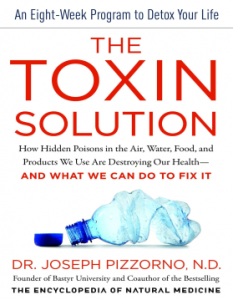
The Toxin Solution
Photo: Joseph Pizzorno
We are surrounded by invisible toxins that are making us chronically sick. They are in the food we eat, our tap water, household cleaning products and health and beauty aids. “They damage every aspect of our physiological function and play a role in virtually all diseases.” So says Josepth Pizzorno, N.D.
After years of research and clinical work in the medical field and nine months of writing he published The Toxin Solution: How Hidden Poisons in the Air, Water, Food, and Products We Use Are Destroying Our Health–and what we can do to fix it (HarperOne, $15.99) this year.
In his 280-page hardcover book with lengthy end references, written for a broad audience, he explains how toxins have permeated our lives and proposes a nine week detox program. The book is divided into eight chapters and eight appendices. He explains that toxins are not the only cause of illness, but that they magnify existing issues. They are linked to all chronic diseases such as cancer, dementia, diabetes, and heart disease, he says.
When asked if the average person may affect change to maximize their chances of getting rid of or not be affected by the toxins, he replied by email, “Yes. Paying attention can eliminate 90% of toxins.”
Readers following his eight week plan and a bonus week at the end, he says, may learn how to avoid toxins, boost their defenses by strengthening their detox organs such as the gut, kidneys and liver; and help their bodies excrete and release toxins and repair toxin damage. For example, in the chapter Clean Up Your Gut he discusses nonsteroidal anti-inflamatory drugs, alcohol, high fructose corn syrup and shares information on the correlation between soft-drink consumption and fatty liver disease.
To a question about the source of greatest concern when it comes to toxins the author said, “The surprising answer is arsenic. #1 according to the CDC, which I have independently confirmed looking at a lot of research.”
In the book he says that the average person’s detox capacity is severely diminished by the time he or she reaches old age. When asked about the best way to stay ahead of that issue he replied, “Avoiding toxins. Yes, simplistic, but they poison the actual systems we use to get rid of them. Also, optimizing nutritional status helps protect the detox enzymes by helping them work better and be less susceptible to toxin damage.” When asked if there is a facility or retreat he recommends for people unable or unwilling to follow the detox regimen he proposes he replied, “True North. healthpromoting.com/”
Pizzorno is a leading authority on science-based natural and integrative medicine. He founded and served twenty-two years as president of Bastyr University, among the country’s first and largest fully accredited universities of natural medicine. He is the coauthor of The Encyclopedia of Natural Medicine and Textbook of Natural Medicine. He is a founder and board member of the Institute for Functional Medicine and founder and editor in chief of Integrative Medicine: A Clinician’s Journal, a peer-reviewed journal in integrative medicine. He travels world-wide, consulting, lecturing, and promoting science-based natural medicine.
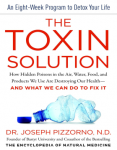
Click to buy The Toxin Solution
Posted by Elena del Valle on October 12, 2017
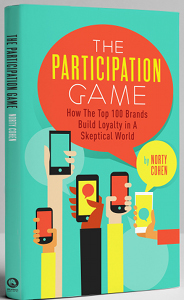
The Participation Game
Photos: Norty Cohen
Old style advertising has become an act of indecent exposure, that is out of touch with Millennial consumers and indicates the degree of desperation of the advertising brand. That is what Norty Cohen, chief executive officer, Moosylvania, believes after examining the replies of paid mobile survey respondents aged between 17 and 37. In his first book, the product of two years of labor, he outlines his thoughts on the subject.
The Participation Game How The Top 100 Brands Build Loyalty in A Skeptical World (Ideapress Publishing, $24.95), was published this year for marketers “hoping to reach millennial consumers – which is a broad 20 year demographic, born in 1980 to present.” The 226-page softcover book is divided into nine chapters with limited text, some black and white photos, varied font sizes and types, and graphic design elements.
When asked what promoted him to write a book he said by email via his publicist, “Yes – the process of writing a non-fiction book was enlightening. It starts with a thesis that can be supported in a compelling and differentiating style. Since our inception in 2003, we have served clients with both an integrated marketing agency and a research facility. Originally, we used our research tools to answer the questions we needed to better serve our clients. Once we had traction, we decided to share it with a larger audience.
The success has been that we have been able to bring our clients through a logical thought process of how to use the research we conducted over a 5 year period.
We believe there is a continued gap in understanding the deliverable of messaging. Consumers have learned to curate messages out of their life. They are their own marketers. They are in control. Media has always worked from the concept of delivery. We must now look at our connectivity with consumers as a partnership that is a living, breathing entity.”
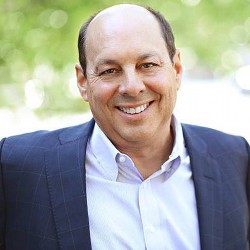
Norty Cohen, author, The Participation Game
When asked which market segments the respondents represent Cohen said, “We worked hard to get a diversified base both demographically and geographically. All surveys were mobile only. The age segments from this year’s report were in 10 year increments, 17-27 and 28-37 years old. Some years we broke it into 5 year segments but we kept it the totals and measurement even.”
The first part of the Top 100 List 2013-2017 is filled with easy to recognize company names beginning with Apple. Next in descending order are Nike, Samsung, Target, Amazon, Sony, Wal-Mart, Microsoft, Coke and Google. Because some brands tied there are more than 100 brands on the list. The last names, also in descending order, are REI, Mazda, Carter’s, Publix, Anheuser Busch and YouTube (tied), Urban Decay, Anthropologie, Subway, Johnson & Johnson & PG (tied), Guess, and Ross.
“Our research show that consumers choose to participate in brands, they do not consume advertising,” he said when asked how and why consumers adopt brands. “We found that word of mouth from friends and family, on line word of mouth, infleencers (influencers) and written reviews are 2.5 more likely to encourage brand adoption that TV, Facebook and You Tube ads combined. Consumers create the exponential reach that makes them a dominant force.”
To what is the take away for a non profit or small company on a shoestring budget – how can they develop brand recognition? he replied, “Ultimately it comes down to delivering great ideas that get consumers motivated to share with their friends. It’s not about your target market. It’s about your target’s market.”
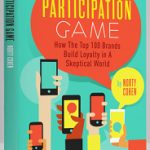
Click to buy The Participation Game
Comments:
Filed Under: Books
Posted by Elena del Valle on October 5, 2017
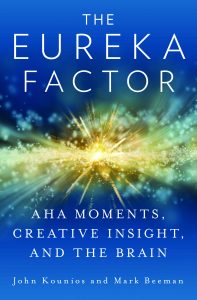
The Eureka Factor
Photos: Random House, John Kounios
There are two types of thinking, procedural and insightful, each one with its own characteristics. So say Mark Beeman, Ph.D. and John Kounios, Ph.D., psychology professors who have researched human thinking processes for more than a decade, in The Eureka Factor Aha Moments, Creative Insight and The Brain (Random House, $28).
In the 274-page hardcover book, published in 2015 and divided into 14 chapters, they outline their findings and theories about both, focusing on creative or insightful thinking. To study the brain under controlled circumstances (in the lab) the authors relied in part on remote associates problems, which may be solved using either type of thinking. Publishing their book took five years.
“The target audience is everybody,” said Kounios by email when asked about the primary target audience for the book (although Beeman replied to emails he was unavailable to answer questions for this note for personal reasons). “People in business, the arts, education, the military, etc., are all interested in creativity and its enhancement. So we tried to make the book accessible and inspirational. We also tried to make is useful for psychologists and neuroscientists by including references and technical explanations in the endnotes.”
Your mood affects your thinking; watch a feel good movie and you might stimulate your creative side, the authors say. But, on the other hand, you can’t remain on a constant loop of creative thinking. Watch the news or a horror movie to change your mood and your style of thinking too, they explain.
If someone is working on a problem, is it accurate to assume that relaxing and being in a good mood is likely to prompt insightful thinking? “Yes, this is one of those indirect ways of facilitating insights,” Kounios said. “When you are in a positive mood and relaxed, this literally expands the scope of thought to allow you to consider remote associations – crazy, long-shot ideas – that are the stuff of creativity. But when you are anxious, you have mental tunnel vision. You focus on the immediate, straightforward, and obvious. That facilitates deliberate, analytical, Type-2 thinking, but it squashes creative insight.”
Why do the types of thinking matter? Because many of us seek to control or at least learn how to stimulate our creative abilities in order to be inventive and think out of the box at work being aware of the factors that influence our style of thinking is a first type in that direction, the authors say. They point out that your surroundings also matter. Outdoor colors such as blue and green are helpful to promote insightful thinking, but red has the opposite effect.
When asked if mental training works Kounios replied, “When you ask if mental training works, I assume that you mean does it work to increase creativity. The answer is yes and no. Mental training can teach you strategies that you can use to come up with creative solutions to problems. But these strategies probably won’t make you a creative person. Cognitive psychologists distinguish between two types of thinking. Type 1 thinking is unconscious and associative. You can’t easily affect it. Type 2 thinking is conscious, deliberate, and methodical. You can be trained to learn Type-2 mental strategies, but you can’t learn Type-1 strategies because there aren’t any. Your unconscious mind doesn’t care about your strategies, deadlines, etc. It does its own thing. Aha moments, what psychologists call “insights,” are unconscious creative processes that suddenly burst into awareness. So, insights are the product of Type-1 thinking that can’t be directly influenced. However, you can sometimes use Type-2 strategies to come up with ideas. The limitation with Type-2 strategies is that they only work when you deliberately use them. When you aren’t deliberately using them, they don’t work. However, you can have a Type-1 insight anytime and anywhere, for example, while daydreaming in the shower. And these aha moments sometimes give you the answer to a problem that you didn’t even know that you had, a problem that you weren’t previously aware of. Training won’t teach you to have such aha moments, but there are indirect ways to influence your unconscious mind to have more of them.”

John Kounios, Ph.D. co-author, The Eureka Factor
“The best way is to unleash unconscious, Type-1 thinking,” Kounios said when asked what is the best way to increase creative thinking. “This is involves expanding attention and the scope of thought. To do this, get yourself in a positive mood, be in a large physical space that will allow your attention to expand such as a large room with high ceilings or outdoors; isolate yourself from demands (i.e., be alone and turn off your phone) and things that grab your attention because those your scope of thought; and get lots of sleep because during sleep the brain purges useless information and enhances potentially useful details and associations. Of course, sleep also improves your mood. The important point is to allocate blocks of time in which you are alone, relaxed, expansive, and in a good mood. Then pick a topic and let your ideas flow freely without forcing them into particular directions. This is how many great ideas occur.”
Kounios is in the early stages of a new title that looks at creativity from a broad perspective and features new research. Since The Eureka Factor was published there have been new findings.
When asked about them the author said, “Yes, several new findings which will be published in the coming months. I’ll mention just one that was recently published. We looked at peoples’ solutions to four different types of puzzles. For all of these puzzle types, when people offer a solution that they say that they got by a sudden insight, it is more likely to be correct compared to solutions that they say they derived methodically and analytically. It seems that when a person is thinking analytically, they tend to get sloppy or rush or not check their thinking, so they make mistakes. But the unconscious thinking that results in insights can’t be rushed – it occurs in its own time and yields an answer when it is complete. This means that it is more likely to be correct. That’s why genuine aha moments – ideas that suddenly pop into awareness and seem striking and obvious – are more likely to be correct than ideas that are the product of deliberate, logical thought.”
At the time of publication Beeman was professor of psychology of Northwestern University, and Kounios was professor of psychology and director of the doctoral program at Applied Cognitive and Brain Sciences and Drexel University.

Click to buy The Eureka Factor
Comments:
Filed Under: Books

































